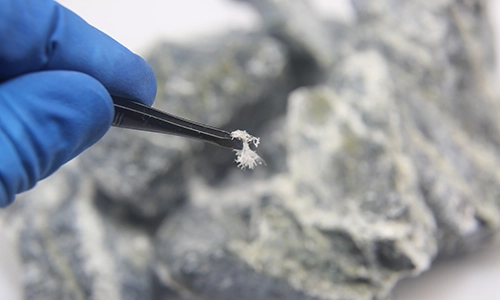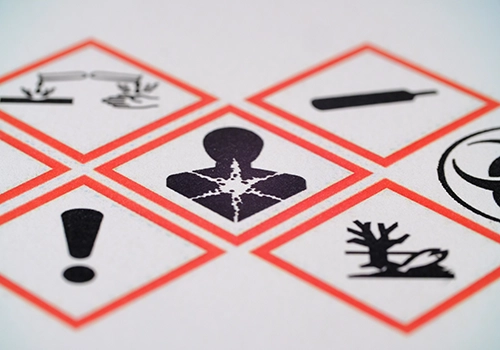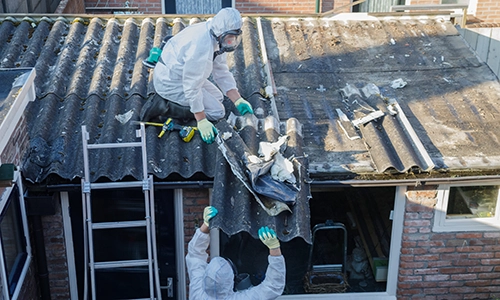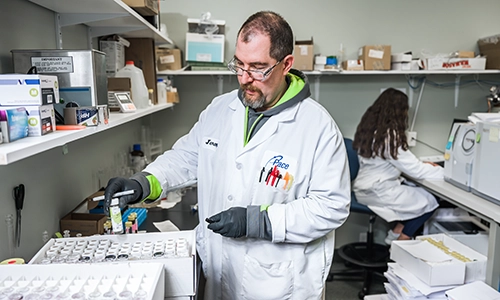Your Trusted Partner For Asbestos Testing And Analysis
Pace® has provided testing for asbestos in air, water, bulk, soil, and dust samples for more than 30 years. We use state-of-the-art laboratory equipment and industry-approved methodologies to ensure accurate and reliable results so our customers can make better decisions faster and confidently comply with all industry standards and regulations.

What Is Asbestos?
Asbestos, a mineral known for its carcinogenic properties, is comprised of flexible fibers that possess resistance to heat, electricity, and corrosion. These properties made asbestos valuable for various commercial products such as insulation and fireproofing materials, automotive brakes, and wallboard materials. However, these same qualities contribute to the health risks associated with asbestos exposure.
What Are The Health Hazards Of Asbestos?
Asbestos is a well-recognized health hazard and highly regulated by various agencies, including OSHA and the EPA. Breathing in asbestos fibers can cause asbestosis, which is a scarring of the lungs. This can lead to a loss of lung function that often worsens and can lead to long-term disability and even death. Asbestos exposure may also lead to lung cancer and mesothelioma of the pleura, a fatal tumor affecting the lining of the lung or stomach cavity. Recent research has shown that all types of asbestos, including the commonly used chrysotile, can be hazardous.


How Does Asbestos Exposure Occur?
When asbestos-containing materials are disturbed during activities such as product use, building or home maintenance, repair, demolition work, and remodeling, asbestos fibers may be released into the air. Damaging or disturbing these materials causes particles and fibers to be released into the air.
Techniques For Asbestos Detection
The presence of asbestos in a material sample is typically confirmed using PLM. Asbestos fibers form bundles, with individual fibers split at the end. These can be seen under a microscope using polarized light. Asbestos minerals also have characteristic refractive indices. By embedding the fibers in well-defined index-matching liquids, different types of asbestos can be identified.
PCM is used to test air filter samples that have been collected to monitor asbestos concentrations in the air before, during, and after asbestos remediation. Using a PCM microscope, the analyst counts the fibers present on the filters to determine whether the total fiber concentration exceeds the EPA clearance level of 0.01 fibers/cc (fibers per cubic centimeter). PCM results do not distinguish between asbestos and non-asbestos fibers.
TEM can identify asbestos fibers by analyzing their appearance, chemical composition, and crystal structure. This method can analyze very fine fibers and determine their composition and structure simultaneously. An energy-dispersive X-ray detector is used to determine the chemical composition of the fibers, and a diffraction pattern can be obtained to distinguish between amorphous and crystalline fibers.

How Is Asbestos Regulated?
Asbestos is covered by a wide range of state and federal regulations designed to protect public health. Many of the primary programs are listed below.

Part of the Toxic Substance Control Act, AHERA mandates the EPA to create regulations requiring local educational agencies to inspect school buildings for asbestos, create asbestos management plans, and take action to reduce or prevent asbestos hazards. Additionally, under AHERA, the EPA developed a model for states to use when accrediting individuals who perform asbestos inspections and corrective-action activities in schools.
ASHRA extended the funding for the asbestos abatement loan and grant program in schools, directed the EPA to expand accreditation requirements to include asbestos abatement projects in all public and commercial buildings (including schools) and increased the number of training hours required for the Asbestos Model Accreditation Plan (MAP).
The CAA defines the EPA's responsibilities for protecting and improving the nation's air quality. This law includes provisions that allow the EPA to set national emission standards for hazardous air pollutants, including asbestos.
The SDWA gives the EPA the authority to set National Primary Drinking Water Regulations (NPDWR) and enforce maximum contaminant limits (MCLs) on contaminants in drinking water. The chemical contaminants rules regulate over 65 contaminants, including asbestos. When asbestos levels exceed the EPA-defined MCL, water suppliers are required to notify customers within 30 days of the violation.
CERCLA, sometimes referred to as Superfund, is designed to remedy threats from unexpected releases and historical mistakes in hazardous waste management. CERCLA regulates the cleanup of abandoned hazardous-waste sites as well as accidents, spills, and other emergency releases into the environment, including the release or potential release of asbestos.
The asbestos NESHAP regulations specify work practices to be followed during the demolition or renovation of all structures, installations, and buildings, excluding residential buildings with four or fewer dwelling units. The building owner or operator must notify the appropriate state agency before any demolition or renovation of buildings that may contain a certain amount of asbestos or asbestos-containing materials. Certain manufacturing and fabricating operations must avoid emitting visible emissions into the outside air or follow air cleaning procedures. Asbestos-containing waste removal also has specific requirements.
OSHA sets and enforces protective workplace safety and health standards. OSHA has promulgated regulations that establish permissible exposure limits (PEL) for air in the workplace.
Although the CPSC does not have specific regulations governing asbestos in consumer products, their mission is to protect the public against unreasonable risks of injury or death from the use of consumer products. The CPSC's role in regulating asbestos is primarily focused on monitoring and assessing potential risks and to work alongside other agencies to ensure the public is protected from asbestos exposure.
MSHA oversees the safety and health of miners in the U.S. To achieve these objectives, MSHA has laid out rules regarding asbestos exposure limits, engineering controls, and respiratory protection measures for workers, particularly in surface mines. Additionally, MSHA has been proactive in augmenting protections for miners exposed to asbestos. Lastly, MSHA also looks into the potential exposure of miners to asbestos in commercial products found at a mine.
Who We Serve
Construction
Building renovation and demolition can easily disturb known and unknown asbestos-containing materials (ACMs).
Environmental Engineering & Consulting
When asbestos is suspected, consultants are often called on to prepare and oversee abatement and remediation planning and perform clearance testing.
Asbestos Abatement Contractors
Once asbestos is identified, qualified abatement contractors can remove the asbestos, or if removal is impossible or impracticable, mitigate it so that it cannot cause harm to anyone who lives or works in the building.
Additional Resources
Need to find a lab that can handle your unique requirements?
Contact us directly or download our list of environmental certifications across our network.
Info Sheet: Asbestos Testing